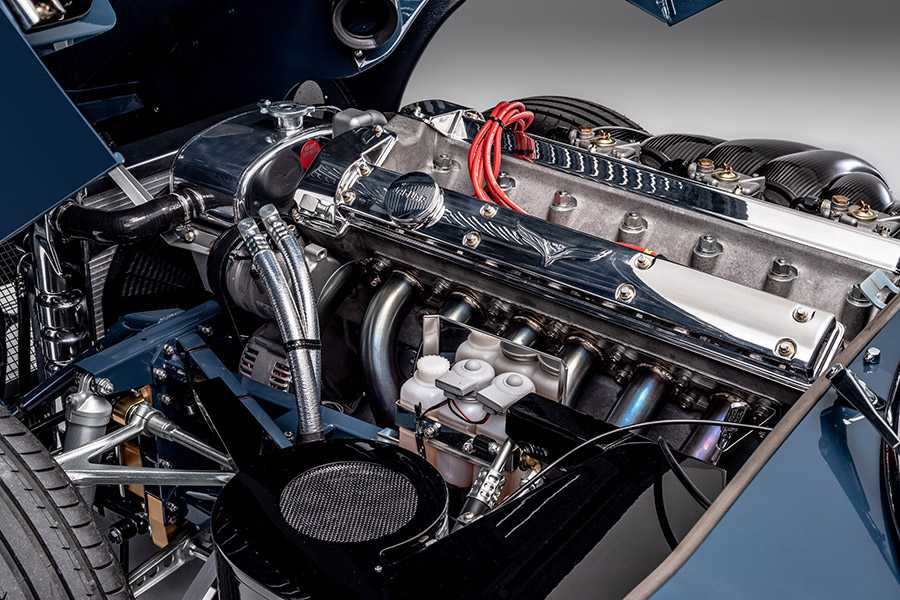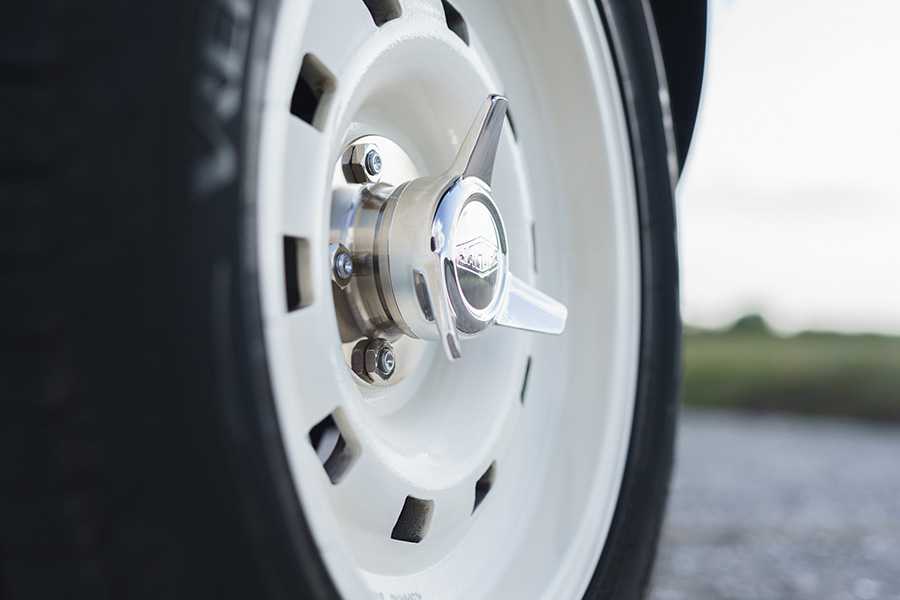The Special Jaguar E-Type Eagle Speedster
Via EagleGB
The Jaguar E-Type that the Eagle Speedster is based on is a hands-down gorgeous car. Even by today’s standard — more than six decades later — the E-Type, also known as the Jaguar XK-E for the North American market, is a stunning wonder on wheels. It was a British-made sports car manufactured by Jaguar Cars Ltd between 1961 and 1974, combining beauty, brains, and competitive pricing to establish its iconic status in the global automotive scene.
Imagine boasting a 0 – 60 mph acceleration under 7 seconds in the ’60s and early ’70s and a top speed of 150 mph. It rode on a unibody construction, which is a fully integrated body and frame chassis. It had disc brakes, rack-and-pinion steering, and independent front and rear suspension, which were trendsetting features that set the Jaguar apart from rivals.
Interestingly, Jaguar based the E-Type on the Le Mans-winning D-Type racing prototype, which ultimately reinforces the Eagle Speedster’s deep-rooted high-performance heritage. The D-Type had won the 24-Hours Of Le Mans endurance racing for three consecutive years beginning in 1955.
Via EagleGB
A ladder frame was unnecessary since the D-Type utilized what was at the time a novel design approach, comprising a front subframe cradling the engine and front suspension and front bodywork attached directly to the tub. This chassis design allowed the D-Type to weigh just 2,900 lb.
Milk from the grapevine credited Enzo Ferrari as saying the Jaguar E-Type was the most beautiful car ever made. It might sound far-fetched that Enzo Ferrari actually used those words to describe the Jaguar, but he would’ve been talking about beauty, not power, which admittedly, Enzo Ferrari would’ve never openly admitted another brand to be better at.
Besides the il Commendatore, a 2004 edition of Sports Car International ranked the Jaguar E-Type at the apex of Top Sports Cars of the 1960s. In 2008, the Daily Telegraph scored it number one on its list of the world’s most beautiful cars of all time. But the E-Type is revered across industries. It has appeared in features and television series, including Mad Men, Diabolik, and Austin Powers.
The Eagle Speedster Is A Classic Reborn
Via EagleGB
It speaks more than volumes that Jaguar’s own Design Director Lan Callum confessed that he’d prefer Eagle’s version of the Jaguar E-Type to the original. «If I were to have an E-type,” said Callum, “it would have to be the Eagle Speedster — I just love that car. It’s how I would have designed it; it’s taking the E-type Jaguar’s purity to a whole new level.”
Like many bespoke and special-edition exotics, the Eagle Speedster project began as a request from an adventurous fan, in this case, an Eagle customer known as Dr. Rick Velaj from Connecticut. With the word ‘speedster’ thrown around a lot during conversations between Dr. Rick and Eagle’s technical and design head Paul Brace, a pencil sketch was soon drawn, which the trusty customer loved, and thus began the development of Eagle Speedster No.1.
Paul went to work deploying the firm’s time-honored experience in E-Type engineering while ensuring the concept is as faithful as possible to the ‘60s Jaguar E-Type, complete with the period’s classic detail and finishing. However, the custom-designed aluminum rimmed wheels are a deviation from the original classics, which is necessary to enhance not just the Speedster’s beauty but also how it handles on the road.
Via EagleGB
Doing away with the original 3.8-liter engine, Eagle Speedster rolled out with a 4.7-liter inline 6-cylinder mill mated to a 5-speed manual gearbox and optimized suspension system. Notably, the original E-Type delivered power to the wheels via a 4-speed transmission. The Eagle Speedster can make an all-aluminum 330 horses at 4,800 rpm. Weighing 2,222 lb, it could the 60 mph in less than 5 seconds. This also means Eagle Speedster is approximately 550 lb lighter than a stock open-top Jaguar E-Type.
The custom-built lowered and raked windshield with wind-down side glass and hidden ‘A’ posts enhance the car’s sleek profile. The exterior design is further augmented by the custom-designed enamel horn push, flush-fitting nose, and tail badging. The flowing body is pronounced by the rear decking which extends further centrally and drops into the cockpit, effectively creating a ‘waterfall’ console. The flowing forms persist such that even the number plate aperture for the US market seamlessly narrows to fit the flowing form.
Via EagleGB
The sculpted cockpit painstakingly mirrors the original thing, right down to the aluminum fascia. However, the handbrake together with the iPod contact point (which would’ve been out of place in a ’60s Jaguar) is now squirreled away under the cubby lid. This is a two-pronged design approach where the concealed handbrake lever does not interrupt the smooth lines flowing inside the cockpit, and the ‘modern’ iPod connection is out of sight.
Via EagleGB
In keeping with the tradition of the original E-Type, the Eagle Speedster had to be an open-top 2-seater roadster. The problem, however, is that you don’t want to be on the road in it when it suddenly starts raining. Thankfully, Eagle launched a new Spyder GT version of the car with a folding cloth top.
High demand for the Eagle Speedster from all over the world proved too hard to ignore. As such, what was supposed to be a one-off prototype ended up with several copies, although the car remains an ultra-limited-production restomod.
From hand-forming to 3D Printing
Ultra-lightweight magnesium alloys are specified for the gearbox case, bell housing, differential case, sump and rear hub carriers. The gearbox has been uprated to a carefully re-engineered, all synchromesh five speed unit, taking care to provide a perfect period feel to the change with no compromise in the position of the lever. There is no compromise allowed in the gearbox ratios either, as each one has been designed to ensure a seamless flow of torque that is ideally matched to the weight of the car and the characteristics of the engine.
Through extensive use of specialist lightweight materials including magnesium, Inconel and titanium, the Eagle Lightweight GT weighs just 1017 kg; not in stripped-out race configuration, but luxuriously specified and fully air conditioned for comfortable road use.
Comfortable road use also means resisting the temptation to give the Eagle Lightweight GT an exhaust note that shouts ‘race car’ or a track-focussed suspension calibration that too often makes such vehicles too harsh. “Far more challenging is to combine taught, sportscar dynamics with the ride quality and refinement of a world-class Grand Tourer,” explains technical director Paul Brace. Working together with the seats and tyres, Eagle’s lightweight suspension, carefully specified geometry, spring rates, bushings and bespoke Ohlins adjustable dampers, ensures long distances can be completed in refreshing comfort.
 Eagle’s hand-built engine, lightweight suspension and subtly integrated airconditioning system
Eagle’s hand-built engine, lightweight suspension and subtly integrated airconditioning system
That attention to detail is continued throughout the Eagle Lightweight GT in the most comprehensive review and enhancement of an E-Type ever undertaken, accomplished with great sensitivity to the original feel and aesthetic. Take the driving position as an example. The design of the floorpan, pedal mountings and the rear bulkhead have been tweaked to dramatically increase legroom in the E-Type’s notoriously cramped cabin while the seats are redesigned to improve safety, retention and long-term comfort. The remarkable attention to detail has even increased finger room around the seat adjusters, using the latest 3D printing techniques to create bespoke control levers.
Most of the revisions, like the gorgeous peg-drive magnesium alloy wheels and aluminium three eared wheel spinner nuts, could be described as ultimate evolutions of the correct period technologies, but there are also carefully selected modern systems that have been discreetly integrated. Braking is by four piston, servo assisted vented discs, a subtly integrated electrical distribution panel increases safety and reliability and the extreme cabin heat of the original is solved by modern thermal barrier materials and the careful integration of a discreet airconditioning system; designed in-house to eliminate the compromises that would be inevitable with a bought-in design.
 The lightweight, 16” racing wheels are manufactured in magnesium alloy specially for Eagle. Exquisite three ear spinners are machined from aviation-grade aluminium billet
The lightweight, 16” racing wheels are manufactured in magnesium alloy specially for Eagle. Exquisite three ear spinners are machined from aviation-grade aluminium billet
Pearman says the Lightweight GT is a classic supercar that fuses the character and charm of the original Jaguar E-Type with the intoxicating thrills of a 1963 factory Lightweight, thoughtfully and comprehensively re-engineered to ensure the new owner enjoys every mile, every day. For enthusiasts wanting to wrap the intense flavours of ‘60s motorsport in the sumptuous, hand crafted comforts of a luxury GT, “this,” he states with confidence, “is as good as an E-Type can be.”
Автомобили Eagle – что это за машина
Автоконцерн производил легковые машины для внедорожья и скоростных магистралей. Все автомобили марки Eagle отличались маневренностью, надежностью и небольшим расходом топлива на 100 км.
Производитель основывался на надежности узлов и агрегатов, экономичности в потреблении топлива и ремонтопригодности. Простота сборки комплектующих достигнута заимствованием разработок компаний Dodge и Mitsubishi Motors. Марка Eagle при использовании идей этих производителей имела свой логотип в виде головы орла и неповторимый дизайн кузова.
Но главная особенность автомобилей – это удлиненная колесная база, двигатель мощностью 110 л. с. емкостью 4,2 л. Модели бренда Eagle имели трехступенчатую автоматическую коробку передач и расходовали бензин 12-14 л на 100 км.
Логотип марки Eagle
Последний автомобиль бренда Eagle сошел с конвейера в 1997 году, но в Америке и нашей стране можно встретить эти экземпляры на дорогах. Потребители ценят в машине качество сборки, динамику двигателя и простую управляемость на дорогах.
Как появилась компания
Eagle – это подразделение автомобилестроительной торговой корпорации «Американ Моторс», которое основано в 1979 году. Компания изначально занималась производством легковых моделей в средней ценовой категории с малым расходом бензина, а с 1987 года выпускала серию внедорожников.
Новые автомобили разрабатывались совместно с Mitsubishi и по дизайну и основным технологическим узлам были похожи на японские машины.
В истории автомобильной марки Eagle было много проблем, связанных с переходом бренда от одного собственника к другому. Под торговой маркой выпускались копии автомобилей компаний Mitsubishi и Chrysler, но с оригинальным логотипом «голова орла».
Причины упадка Eagle
Производство процветало на фоне нефтяного кризиса в Америке, но смена собственников и небольшое разнообразие в дизайне кузова, имели последствия. История бренда Eagle насчитывает несколько крупных слияний с автомобильными компаниями Mitsubishi, Jeep и Chrysler-Plymouth с 1987-1993 гг., но это не принесло успеха. Продажи осуществлялись через дилерские сети этих корпораций, и небольшой модельный ряд Eagle не мог конкурировать с крупными концернами.
Eagle Talon
Компания закончила свое существование в 1999 году. Производственные мощности, на которых создавались легендарные автомобили, перешли в собственность Mitsubishi и Chrysler.






























